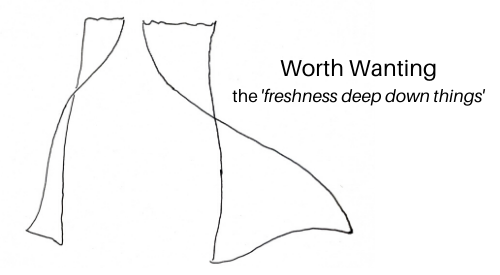
Who’s invited to the party? The birthday? The coming out? New Year’s Eve? The tired-of-lockdown party?
I’m talking about encounters. Who is invited to be present in an encounter? There a one, and an other. Two. Company, not crowd. But what about spectators looking on? What about otherwise-occupied bystanders in the vicinity? Where do we draw the line? Lines are important for anything to be something particular and not just everything, so who’s in and who’s out?
Let’s be clear about what an encounter is here: an occasion of making common cause with the livingness of an other. Just that, all of that. Livingness is the only ‘strange’ word here and I’ll talk about it later, as I will the more familiar phrases–an other, common cause–that I use in a special way.
You’ll notice I didn’t say occurrence but occasion, not just the bare event but one rich with opportunity.
Occasions can happen in the midst of occurrences. We’re immersed in a stream of occurrences, and not just carried along, but often swimming stoutly to somewhere we want to go. The occasions which are encounters may be moments or minutes in that stream. The stream may be flowing and we may be busily going, but the encounter is its own thing in its own place.
So who’s in and who’s out?
Outsiders
Bystanders: These may objects of consideration by the participants in an encounter, indeed may be virtually invited to participate, but are not strictly part of an encounter. Just being in the vicinity, or even engaged in a common activity doesn’t put us inside.
Spectators: We may feel, in this post post modern age, nothing is ‘said’ but everything is ‘signaled.’ Content is secondary to message. But in an encounter, there’s only saying. Messaging or signalling is directed to a party outside: an audience or oneself looking on from a far, but both at a distance from the other in the encounter. Signalling indicates: I’m one (or not) of you; I’m one (or not) of this kind. To message is to cross the line and leave the encounter, or conversely, to summon some third party in to watch, effectively erasing the line altogether. Spectators, real or virtual, have no place in an encounter.
Insiders
The opportunity aspect of the occasion comes from each participant in an encounter fully attending to the other. This means the minimum number of participants in an encounter must be at least two– a one and an other. The otherness of the other is key to an encounter being what it is. This otherness must be recognized, acknowledged and addressed, at least tacitly. It is the foundation of the occasion’s potentiality, energy and power. More aspects of pep here.
There are lots of kinds of others, outer and inner, and you can find them listed here. It’s good to remember that encounters are not just between two people face to face across a table in a coffee shop but can be between a person and a book, a place, an aspect of personal heritage, a work in progress.
And the prime activity of an encounter need not be verbal. Making common cause can occur any of the innumerable modalities of hospitality, friendship and exploration, for example, healing, experimenting, helping. A fuller list of possibilities is here.
A one, an other. Each other to the other. How many in this arrangement? To avoid an infinite recurrence, mirror inside mirror inside mirror, let’s think schematically about insides and outsides between two encounter participants, call them Able and Baker.
Both Able and Baker have interiors, and each is exterior to the other. Let’s call the interior of each, their suitorium, from the Latin for self, sui. Correspondingly, let’s call the whole world of not-selves each have, their alitorium, from the Latin for other, alia.
Granted, some others are inner others, but they also belong in one’s alitorium. Granted also, some things done or said by the other confirm or reinforce aspects of one’s habitual behaviors or opinions. These belong to one’s suitorium.
Considering these crossovers, where is the line between one’s suitorium and alitorium? We might think of it as a perimeter. The actual geometry and topology is multi-dimensional and complex but the wall around a mediaeval town might illustrate what I’m talking about. Inside: the normal business of the community driven by mundane considerations: convenience, efficiency, production with a way of doing things. Outside: resources, strangers, other ways of doing things, threats, customers, and so on. The walls have gates sometimes open, sometimes closed through which passes traffic and goods and out.
It’s a simple picture but let’s make it more complicated by thinking of the walls as dynamic, flexible here, rigid there, expanding or contracting, and as sometimes happens, looping to capture what was outside, or envaginating to cut out what was inside. That dynamism of the boundary I call livingness. (I told you I’d get to the term.)
If there’s no wall, there isn’t the intensity, density and compression that make something anything at all, to make us ourselves, and not just blurry vagueness. All wall, and there’s endless repetition digging an ever narrower rut into reality.
So when Able addresses Baker, Baker is part of Able’s alitorium, which includes both Baker’s suitorium and Baker’s alitorium. But Able’s alterium includes more others than just Baker, though Baker may be the only one actually present and directly attended to at the moment. And vice versa for Baker addressing Able. Also there may be overlaps of alitoria mean both parties may share some other they can both address together.
And this alitorial complexity that each presents to the co-participant is what confronts the suitorium of each.
Whew! A full and busy place.
So who’s inside an encounter? Perhaps only two, but each of them is the world, at least a rich and world-like fragment of it. All outsiders are present, active and potent in any encounter as elements in the alitorium of each, and accessible to the other as such within the encounter space.
The livingness of an other we are making common cause with when we encounter is the dynamism of that boundary between other’s suitorium and alitorium. We’re not breaking down or building up but collaborating with each other as they respond to the opportunities of the occasion with modifications of the contours of their perimeter.
The long-term nature and significance of these changes may only be evident later, and on reflection.
Freshness
There is an insider not mentioned yet: transcendent freshness, that is, freshness inviting us into and issuing forth from the transcendent world. I talk about transcendent world and the mundane in other posts, and about freshness too. Let me focus here just on its presence and role in an encounter.
Freshness is what calls us into encounter and freshness makes encounters special. Encounters are in fact where freshness directly interacts with the mundane world.
In any encounter what freshness does is several things. It gives each participant a sense of the beyondness in its own and the other’s alteria. It bestows a glamour of interestingness on certain items discovered in the alteria. It roots around and reveals unsuspected things and also, poof!, debuts unexpected new things. Not least, it fosters that sense of communion which makes the whole occasion not just possible but positive.
Is freshness a third party? Or the very ground and force of encountering as such, the sine qua non?
